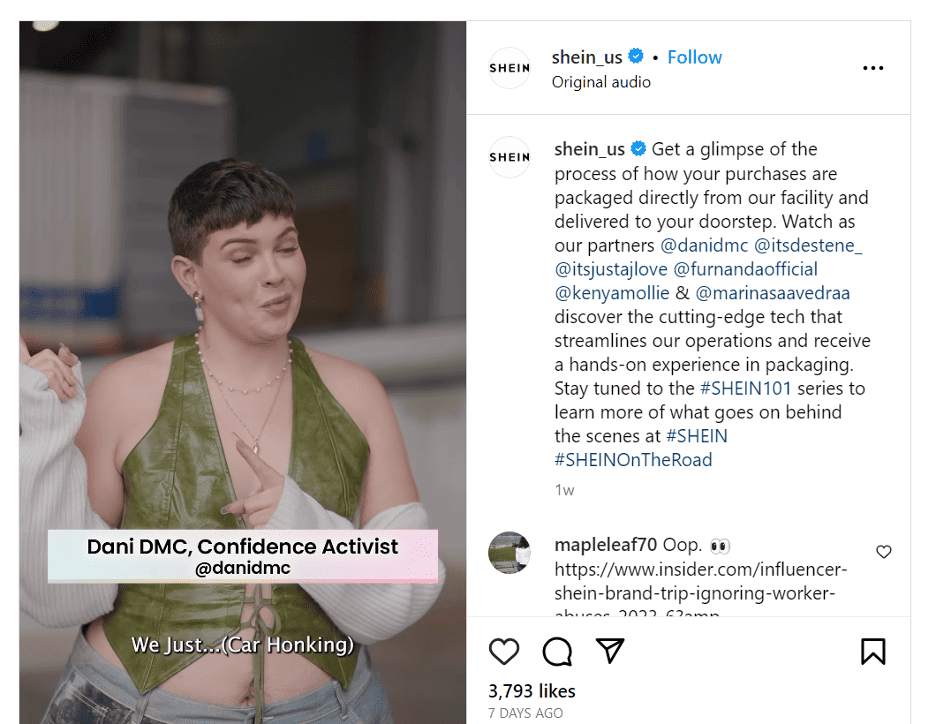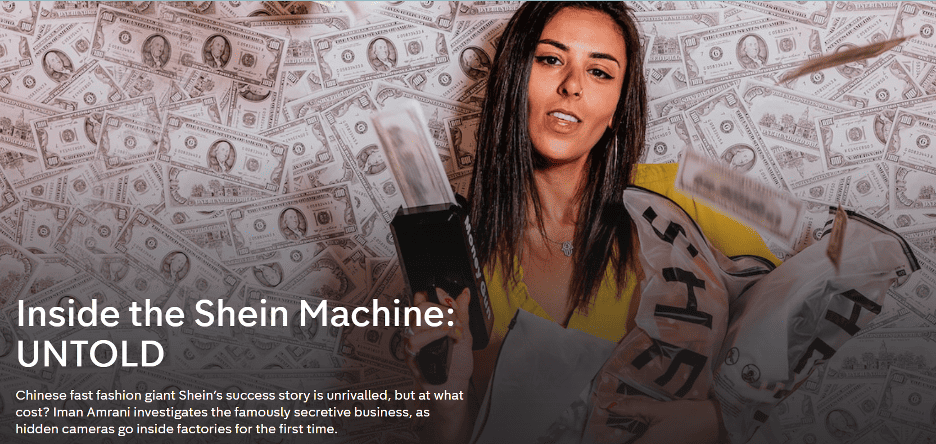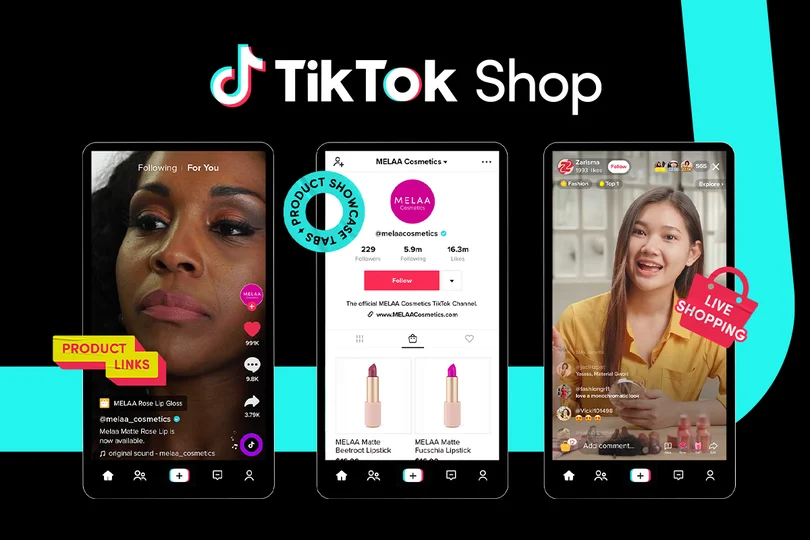Boasting over 29 million Instagram followers and a massive fast fashion market share in the US, Shein has plenty of supporters.[1] But that doesn’t spare it the backlash for alleged environmental harm, abusive labor practices, and other controversies.
In an effort to change that, Shein tried to leverage influencer marketing in a bold move – and failed on a monumental level. This June, Shein opened its doors and invited influencers to tour its factories, only bringing more scrutiny for the company and the influencers who took part.
Allegations Against Shein
Shein has been the subject of many documentaries and news investigations for its working conditions at the Guangzhou factories. A lot was uncovered, including employees working 75-hour work weeks for less than $20 per week.[2]
But that’s not all. The company was reported to be sourcing cotton from Xinjiang, which has been in the public eye after the Chinese government has been accused of holding hundreds of thousands of ethnic minorities in internment camps and forcing them to pick cotton or work in textile factories.[3]
Shein also faced criticism for environmental and health concerns. In 2021, CBC Marketplace revealed that Shein’s toddlers’ jackets contained 20 times the amount of lead that’s allowed in clothing for children, according to Health Canada.[4]
In addition to these issues, the company has been criticized for its high-consumption business model and contributing to environmental pollution. By offering low prices for fad clothing – fast fashion – the company encourages consumers to buy cheap, trendy clothing that’s heavily “influenced” by the runway, rather than investment pieces.
To keep up, Shein produces tens of thousands of garments each day, releasing over 6.3 million tons of carbon each year. This is roughly the equivalent of 180 coal power plants.[5]
In an effort to revamp its image, Shein released a sustainable line – evoluSHEIN – with clothing made in part with recycled polyester. The company’s executive vice president Donald Tang also announced that Shein is moving forward with environmental, social, and governance policies in mind, including the move to invite influencers to visit its factories.
Shein’s Influencer Trip
Shein features a lot of influencers in its marketing strategy to appeal to its largely Gen Z audience. TikTok, in particular, is an important platform for the brand. Influencers use a lot of video content showing their clothing hauls, generating billions of views.
Leveraging influencers is part of why Shein managed to gain such a considerable market share – overtaking other giants like Zara and H&M.
Given previous successes with influencer marketing, it makes sense that Shein would try to use influencers to revamp its image and assuage some of the concerns over labor and environmental practices.
Some of the influencers invited on the trip include Dani Carbonari (Dani DMC), Destene Sudduth, Kenya Freeman, and Marina Saavedra. Fernanda Campuzano, who has a fashion line with Shein, was also invited.
Based on the content posted by these influencers, Shein’s factories seemed to be similar to the standards in the US – automation, clean tables, bright lighting, and employees working normal 10-hour shifts in the “Innovation Factory.”
Along with the factory tour, the influencers’ were treated to luxury hotel rooms, a 10-course dinner, and excursions in Guangzhou, all complements of Shein.
Seeing Is Not Believing
Shein invited influencers for a peek behind the curtain – a move that not many fashion brands allow. Even some of the sustainable brands don’t allow influencers or investigative journalists into their factories.
 Source: Instagram
Source: Instagram
There’s a reason for that. Though these influencers may consider themselves “investigative journalists” – Carbonari called herself that, in fact – they may have missed some of the realities behind the façade while being dazzled on their trip.
Their accounts were mostly positive, exclaiming that they were “independent thinkers” and “saw with [their] own two eyes” the realities. One influencer said she was “excited and impressed” to see the working conditions and said one employee was surprised at the rumors about the factories.
Truth or Misinformation?
The snippet of factory conditions that these influencers saw isn’t the whole story, however. Shein’s transgressions are well documented, even just in the sheer volume of clothing it produces.
According to Good On You, an ethical fashion brand watchdog, Shein received the lowest rating of “very poor.” Part of this rating is because Shein doesn’t seem to be taking any meaningful action to reduce or eliminate hazardous chemicals in manufacturing, minimize microplastic use, or reduce climate impacts.
There’s also the treatment of its workers, which is also rated “very poor.” Based on an undercover investigation documentary, Untold: Inside The Shein Machine, Shein’s workers put in 18-hour workdays and earn just four cents per hour.
 Source: Channel 4
Source: Channel 4
The critical consumers are well aware of these issues, which is what prompted the backlash across social media platforms. The issue wasn’t just the hypocrisy of the influencer tours, but the fact that the influencers were mostly plus-size and people of color – marginalized groups in the influencer sphere who tend to get fewer opportunities for this type of clout.
According to user No Quarter Will Be Given. Shein “chose women that they thought would be desperate enough for the perks.” In the words of the some of the influencers themselves, they were “happy to be included.”
 Source: Twitter
Source: Twitter
The irony is that, in taking the trip to Shein factories and promoting them as safe, fair, and transparent, these influencers perpetuated the exploitation of others while being exploited themselves – and by a company known to be one of the worst abusers of human rights.
What the Backlash Means
Shein has been under fire for years, and a lot of consumers just won’t give up fast fashion. But the negative response to the influencer trip shows that the market is shifting – and even Shein’s decision to bring influencers in could mean it’s feeling the pressure. If influencers, advocates, and consumers continue to hold the company accountable, it could push Shein into a more sustainable and ethical future.
Sources:
[1] https://www.retaildive.com/news/shein-surpasses-hm-zara-in-us-fast-fashion-sales/603160/
[2] https://www.channel4.com/programmes/inside-the-shein-machine-untold
[4] https://www.cbc.ca/news/business/marketplace-fast-fashion-chemicals-1.6193385
[5] http://changingmarkets.org/wp-content/uploads/2022/12/Synthetics-Anonymous-2.0-Report-final-web.pdf



